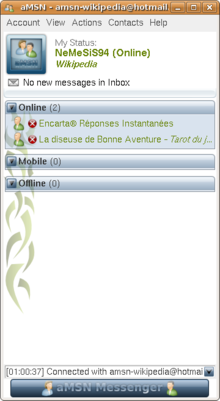AMSN
| Developer(s) | aMSN Development Team |
|---|---|
| Initial release | May 22, 2002 |
| Stable release |
0.98.9 / May 25, 2012
|
| Written in | Tcl/Tk |
| Operating system | Multi-platform |
| Type | Instant messaging client |
| License | GNU General Public License |
| Website | www |
aMSN is a free Windows Live Messenger clone. aMSN attempts to emulate the look and feel of Windows Live Messenger, and supports many of its features. It has been downloaded approximately 40 million times as of January 2011, making it the 21st most downloaded project on SourceForge.
aMSN is available for any system that supports Tcl/Tk 8.5 or higher, including Microsoft Windows, Macintosh and any UNIX/Linux variant, including Maemo (Nokia's internet tablets) and OpenSolaris. A portable version for Windows is available by PortableApps.
aMSN was based on a previous application named Compu's Messenger (ccmsn), released on September 21, 2001 by Dave Mifsud. Features in this application were quite limited and development seemed to be stopped. Alvaro Iradier made a fork of the development with his own version, aMSN (Alvaro's Messenger). At the time Didimo E. Grimaldo was also working on his own branch of ccMSN until both Alvaro and Didimo heard of each other in a development forum and decided to merge their improvements into one version. The first version of aMSN was released on May 22, 2002 on Sourceforge.
After several successful releases of their join effort, Didimo E. Grimaldo decided to take leave as a developer due to other pressing responsibilities and lack of time. ccMSN/aMSN was in fact the last of several free and open source projects in which Didimo worked.
More developers joined the project, like Philippe G. Khalaf and later Youness Alaoui. Today, the project keeps going thanks to the effort and help of an increasing number of developers, translators, and designers.
aMSN is well known for quickly implementing most of the official client's features, often being the only third-party client that supports them. For example, it is the only client that supports video conferencing on Mac. It has been reviewed by many software-specialized websites. Its releases have appeared on several well-known blogs, its developers have been interviewed, and it has even appeared on a few TV series internationally.
With the release of Windows Live Messenger 2009, Microsoft made changes to the protocol used by Windows Live Messenger. These changes included the use of P2P SIP instead of using an external server. As a result of this, the video call function to aMSN was made unusable and was removed from versions 0.98.3 and 0.98.4 of aMSN.
In late 2010, Microsoft released Windows Live Messenger 2011, which removed one-way webcam functionality, meaning that aMSN is left with no practical webcam function.
...
Wikipedia

